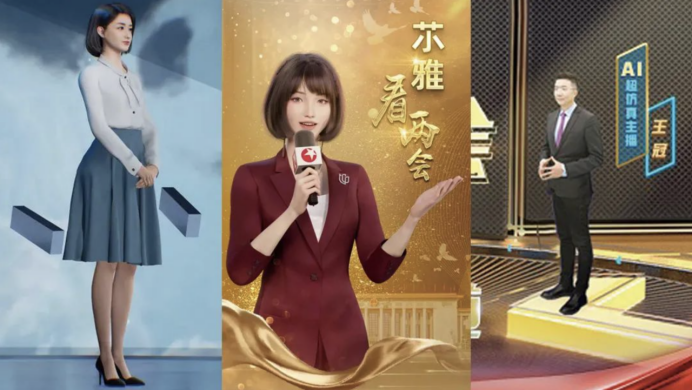In 2022, virtual beings will be in the limelight. Although the future of virtual beings appears promising, getting started in the field is difficult.
Introduction
Following the Winter Olympics, virtual-human anchors have become the focus of attention in the media coverage of the Two Sessions in China. Several media outlets have launched their virtual-human anchors, such as CCTV's Xiao C, SMG Media Center's Shen Xiaoya, and Yangshipin's AI Wang Guan. This creative reporting has attracted many young people to watch.

From left to right, Xiao C, Shen Xiaoya, and AI Wang Guan
The upbeat virtual human
It's not clear how much the virtual human wave is related to the rise of the metaverse, but it's safe to say that the two terms share something in common.
According to the report "2021 Chinese Netizens' Star Chasing Situation Survey" released by iiMedia, more than 80% of netizens have the habit of star chasing in their daily lives, and 63.6% of them once supported and paid attention to virtual idols. Meanwhile, 49.5% of netizens spend at least 500 yuan per month on virtual idols, and 37.6% of them are willing to spend more to support these virtual figures.
In other words, there has been a demand for virtual idols in the market since the ACG culture "broke the circle."
Virtual idols have almost no image tarnishing and moral risks. They are very malleable and cost less than big-name human stars. Therefore, capital and Internet companies have long been eyeing their influence and commercial value. iQIYI, a market-leading online entertainment service in China, launched the first Chinese virtual-human talent show in 2020; Alibaba also has a new national style virtual idol Su Duoduo, virtual character Zhang XiaoZ, etc.

From virtual idols such as Luo Tianyi and AYAYI, to virtual anchors such as Ya Ni, virtual humans are walking into our lives, including entertaining shows, commercial endorsements, e-commerce live streaming, and services like medicine and education.
Virtual humans have made impressive progress with breakthroughs in artificial intelligence, 3D modeling, motion capture, holographic projection, and other technologies. Meanwhile, advancements in display devices, optical components, sensors, chips, and other hardware also help to change the situation. The authenticity and real-time interactivity of virtual humans is significantly enhanced compared to the past, with a few of them being hard to tell between virtual humans and real ones, which laid the technical foundation for this round of popularity.
With the technical foundation and great popularity of virtual humans, the prospects of this emerging industry are pretty promising.
As iiMedia predicted, the virtual idols' market and core business in 2022 will reach RMB 186.61 billion and RMB 12.08 billion respectively.
In Qbitai's "Virtual Human Deep Industry Report", the overall market of China's virtual humans is expected to reach RMB 270 billion in 2030, among which the core size of the identity-based virtual human market represented by virtual idols can reach RMB 175 billion.
Another industry market research platform, Leadleo Research Institute, has a similar judgment, and its "Virtual Human Industry Overview Report Series 2021" predicts that the market size of China's virtual human industry can reach RMB 270.3 billion in the next decade with the development of virtual IPs (intellectual property), virtual secondary avatars and multimodal AI assistant applications. This optimistic expectation has led more and more companies to join the virtual human industry.
Qixin data, an enterprise information search tool, shows that in 2021 alone, there were over 60,000 virtual human-related enterprises in China, and the investment field brought a big deal, too. According to incomplete statistics, in 2021, there were 16 virtual human-related investments, including many well-known investment institutions such as Sequoia Capital, GGV Capital, and FreeS Fund, with financing amounts reaching tens of millions of USD.
In 2022, the enthusiasm for virtual human investment is still high. In just one month at the beginning of the year, the cumulative amount of financing exceeded RMB 400 million.
At present, domestic enterprises have balanced development in the foundation, platform, and application layers of the industry chain. Thus, the system gradually becomes complete from the development to the implementation of virtual humans.
The foundation layer-related firms are mainly concerned with artificial intelligence, motion capture, modeling, and rendering technologies for virtual humans.
iFLYTEK, Jetsen Media, Xinhua Net, DataBaker Technology, Zhuiyi.ai, and Xiaoice specialize in artificial intelligence; YunBo Technology excels in motion capture; Global Mofy, Yizhen Technology, Xuguweilai, Banrenmao, DGene, Faceunity Technology, and Tatame focus on modeling and rendering; Deep Science, Xmov.ai, and Wanxiang Culture are going for the technical services of virtual humans.
Enterprises in the platform layer are mainly responsible for the operation of virtual humans, including appearance design, packaging, promotion, implementation, cultivation, etc. The relevant companies include Vocanese, YUE HUA Entertainment, Dongtu.com, Next Generation, Plus One, Xuniyingye, Motashikong, StarHeir, etc.
Application layer enterprises mainly invest in games, live streaming, animation, film and television, music, and social platforms, focusing on the use of virtual humans for entertainment and marketing. Companies include Mango Excellent Media, Alpha Animation and Culture, and Bilibili, providing virtual anchors and idols in entertaining content.
In addition, China Mobile, Alibaba, Tencent, Baidu, NetEase, and other integrated enterprises also strongly support their subsidiaries or business units to make efforts to build virtual humans.
What is the business prospect of virtual humans?
Despite the frequent appearance of virtual idols in the public eye, the virtual human industry has become a popular target for investors. However, we admit that the current business value of this sector is not yet clear.
Many industry insiders might agree with this point. Li Xiaolong, Alibaba researcher and digital human technology leader, believes that virtual humans are still in a "proof of value" stage, "People are very optimistic about the prospects of virtual humans, but the industry is still in the early stage with crazy investments. "
Take the much-anticipated virtual idols and virtual anchors as an example. Although the related business activities seem prosperous, these virtual humans share a similar operation and commercialization logic to human stars. There is nothing but the fan economy, and only the top ones can make profits through performances, licensing, or related products. While most low-end projects lack a stable fan base or vital communication attributes, they can't accumulate massive Internet traffic quickly. This results in a complicated commercialization procedure that still demands substantial capital commitment.
It is reported that a single song for a virtual idol needs nearly RMB 2 million at this stage, covering arrangements, character design, stage design, and other aspects. With advertising and further investments, the cost of training a virtual idol will surpass that of a human idol. And in the event of low popularity, the content created may not be monetizable, indicating that the entry barrier for virtual idols and anchors is considerably higher than the outside world initially believed.
Currently, renowned virtual idol IPs are primarily engaged in live streaming activities. Due to their cheaper copyright fees, brands are increasingly ready to employ these intellectual properties to substitute actual people's labor to decrease labor expenses. However, this makes it more difficult for them to develop additional business value.
In contrast, B2B virtual humans have a brighter and clearer commercialization prospect.
This form of virtual person is represented by Cui Xiaopan, the 2021 winner of the Best Newcomer Award at Vanke Headquarters.
According to Yu Liang, Chairman of the Directors Board of Vanke Group, with the support of the system algorithm, Cui Xiaopan quickly learns how to identify problems from processes and data and finds various receivables/overdue reminders and anomalies with a thousand times more efficient than humans. With the virtual avatar rendered by deep neural network technology, the write-off rate of prepaid receivables/overdue documents called by Cui Xiaopan reached 91.44%.
This efficiency advantage has inspired many companies. In the financial industry, numerous banks have already launched their virtual agents, such as Pudong Development Bank's Xiaopu, Jiangnan Rural Commercial Bank's VTM, and aiBank's AIYA.
It is conceivable that, with the further development of virtual human technology, more digital employees will appear in the future. Some netizens even quipped, "Cherish the days of competing with real colleagues. They are at least still human. "
As mentioned above, the investment community's enthusiasm for the virtual human industry is also mainly reflected in B2B and upstream of the technology industry chain.
However, investors' preference for B2B virtual humans does not imply that the entrance hurdle is lower.
The production of virtual humans involves a variety of underlying technologies, such as computer vision, graphics rendering, natural speech processing, motion capture, and deep learning, all of which have bottlenecks to overcome.
For example, in the case of virtual assistants such as Siri, the current AI models cannot be ideally generated and driven because the internal algorithms are too complex. Even if the bottlenecks of high simulation in static scenes are broken, how to make virtual humans interact naturally will become an additional problem.
In addition, the higher anthropomorphism and simulation, the greater the technical difficulty. And even worse, each slight improvement in user experience often means exponential investment growth at the technical level.
Take the virtual "Teresa Teng" as an example. It is already a movie-class virtual person with the highest level of simulation and fineness. To develop such a virtual person, we may spend big bucks on constructing models, and the project production cycle is also quite long, and it may take a team of 20 people to work for six months.

Source from online video screenshots
After manufacturing, such a virtual person cannot be directly driven on ordinary PCs but requires the collaborative assistance of numerous computers, and even the rendering process requires a computing network to carry out. Certain firms now build up different rendering farms to accomplish tasks when some servers are idle.
Therefore, compared to startups, the advantages of major corporations in terms of technology, finance, and talent pool are essential. As of now, giants have a strongerstronger chance of prevailing in this virtual human contest.
Ultimately, take some time to consider the situation before jumping into a business venture, regardless of how alluring the sector's prospects are or how profitable the market appears to be.



























